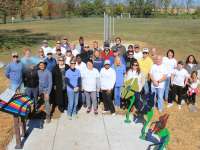Remember when time stood still as you played outdoors with best friends, enjoying the wonders of the world around us? We learned to interact with each other and our natural surroundings — climbing trees, swinging on branches, playing games, or enjoying the quiet contemplation of leaves floating down a stream. Elements of nature created magical expressions of childhood musings about the world.
Like children throughout the ages, we experienced the universal childhood delights of discovery and fascination set free by boundless imaginations and unstructured play in nature — even in a few square feet. New health research recognizes everyday outdoor play in nature as a powerful preventive strategy for healthy childhood development — including protection against childhood obesity.
A generation ago playing outdoors in nature was usually taken for granted, but times have changed. Now, nature must be deliberately designed back into children’s lives. In today’s urban and suburban environments, natural spaces are often too remotely located for visiting on a regular basis.
A playground paradigm shift

The industrial playground model based solely on manufactured equipment is being reconsidered. A greater diversity of play opportunities is desired to extend curricular activity in schools and to meet the needs of a broader range of children and their families in parks. The integration of natural components helps fulfill these needs as well as creating richer play experiences for all users.
Contemporary playground components are manufactured to meet high quality industrial design standards of health and safety. National injury statistics show compliant playgrounds to be much safer than other everyday childhood environments. Playground safety, which has been the focus of playground design for the last fifteen years, has reached the point where some children may find playgrounds boring and therefore not attractive for everyday use or for repeat visits. Therefore, constant upgrading and innovation are recognized characteristics of the playground industry.
To add additional play affordances to the space, naturalization is an effective strategy - it stimulates, motivates, and encourages children’s play and increases the attraction of playgrounds for children and caregivers. Playgrounds cannot fully eliminate risk and indeed should provide children with opportunities to engage in healthy risk taking and activities that provide developmentally appropriate challenges. On the other hand, providing safer environments must continue to be a priority with every effort made to reduce unforeseen hazards.
Naturalization adds value to play equipment structures by enhancing their visual quality as focal points, thereby attracting children outdoors to use parks and school grounds. Equipment, combined with natural elements, tells children that playgrounds are their special places. The added comfort and aesthetic enhancement of nature also encourages accompanying adults to become enthusiastic users.
Naturalization strategies and the best practice principles outlined in our guidebook, Nature Grounds®: Putting Nature Into Play™ offer a new, alternative paradigm for the playground industry, responding directly to the need for children to be outdoors engaged with nature.



